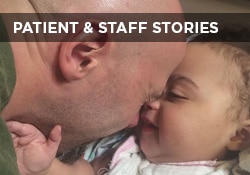This website uses cookies so that we can provide you with the best user experience possible. Cookie information is stored in your browser and performs functions such as recognising you when you return to our website and helping our team to understand which sections of the website you find most interesting and useful.

Susan E. Mazer, Ph.D. Blog
Thoughts and ideas on healthcare
Hi, and welcome to my blog! I'm Susan E. Mazer -- a knowledge expert and thought leader on how the environment of care impacts the patient experience. Topics I write about include safety, satisfaction, hospital noise, nursing, care at the bedside, and much more.
Patient Safety: Now and Always
March 5, 2021
To a patient, safety is an assumption. The idea that they are unsafe when they are sick enough to even go to an emergency room or be admitted to a hospital, is unimaginable. Patients and families assume that the hospital is a haven of care and consideration, a place where those who care for them have their best interest in mind in every action, and they are well protected.
Today, the risks that were around prior to the pandemic are still happening. But, with COVID-19, those risks are changing. We should acknowledge that the risk is lowering with the vaccine, but, the virus has mutated several times, a clear sign that our journey to normalcy and recovery is not yet over.
Patient Safety Risks: Then vs Now
Patient safety risks were identified and documented by Florence Nightingale in the middle of the 19th Century. Both then and now infections, patient falls, distractions, undue distress, and errors remain common to the hospital experience.
Without the medications and technologies that we have today, Nightingale called for a dignified and humane culture, calmness, and ongoing sensitivity to the fragility of the patient. She wrote that while we might attribute symptoms to the diagnosis, the patient might literally experience “the want of fresh air, or of light, or of warmth, or of quiet, or of cleanliness, or of punctuality and care in the administration of diet, of each or of all of these.” Nightingale continued to state that when one is “entrusted with the health of another,” separating symptoms generated by the environment and standard of care from the symptoms of the disease is critical.
How does that translate into practice today? How does the reality of our current and complex healthcare organizations ensure the kind of safety that is required and expected from our caregivers?

The Key to Infection Control, Is the Environment
COVID-19 reinforced the dictum that the environment in which patients are cared for is the primary caregiver. Nightingale posited, that the environment holds the key to infection control, fall and risk reduction. Today, the challenges that come with monitoring every person within a hospital unit threatens safety for the entire facility.
The vulnerabilities of patients may be individually identified and measured. However, each factor influences the other factors. For example, poor eyesight, impaired hearing, and fear of falling each contribute to increased risk of falls.
Agitation, impatience, and fear can motivate a patient to do something by their own and for their own reasons. Urgency calls for immediacy. The challenge is slowing down the pace of urgency to allow help to come.
Let’s picture a patient who has multiple lines and IV-poles surrounding them. They may trip over them. When a patient hurriedly needs to go to the bathroom, falls often occur. At night, the risk increases due to low light and being in a strange room. Clutter, which is any object, large or small, on the floor, out of place or unexpected, is a fall waiting to happen. One other factor that informs fall risk is noise, strange sounds and muffled conversations can be both annoying and distracting.
In each of these cases, the environment, physical, spatial, aural, and visual, pairs up with the patient’s condition. However, the environment can be modified to mitigate some of these risks.
The C.A.R.E. Channel: Your Patient Safety Shield
From its beginning in 1992, The C.A.R.E. Channel has been produced to increase restfulness and decrease restlessness.
-
- C.A.R.E. provides calming music that helps mask distracting noise
- C.A.R.E. offers stunning natural landscapes that are comforting
- C.A.R.E. provides a midnight starfield as a cue that it’s time for rest at night, while imbuing a soft light in the room
C.A.R.E. Programming eases the long hours, between treatments and offers evidence of caring over the full 24-hour patient day. C.A.R.E. answers the question about who takes care of the patient when the staff is not in the room.
Patient Risks = Staff Risks
Further, during this pandemic, the risks to the staff are as high as they are to patients. The best practices and best available research are being discovered in real time. A recent article in The Journal of Environmental Research and Public Health specifically looks at the way the pandemic has impacted organizational resilience, patient safety, and staff retention. Their recommendations point directly to an environment of trust, psychological safety, and empowerment in order to benefit directly from a growing knowledge bank and immediate experience.
If patients assume their safety is a given, then the whole healthcare team, collectively and individually, must also assume their roles to be both caregivers and guardians of the space.
Providing The C.A.R.E. Channel is providing a living symbol of the personal and on-going caring of the staff. By its impact, C.A.R.E. reduces the risks that originates with being seriously ill, frightened, and in an unfamiliar environment.
C.A.R.E. provides a soft and effective solution for serious challenges that are lived moment to moment by patients, families, and staff.
Patient safety is a choice as well as a mandate. It requires universal diligence and attention. We must continue to learn how take care of and protect the patient and everyone within the patient’s domain.
Here are some helpful resources you can use to improve safety at your hospital:
Hospital Noise & the Patient Experience whitepaper by Dr. Susan E. Mazer
Increase Patient Safety by Creating a Quieter Hospital Environment whitepaper by Dr. Susan E. Mazer










